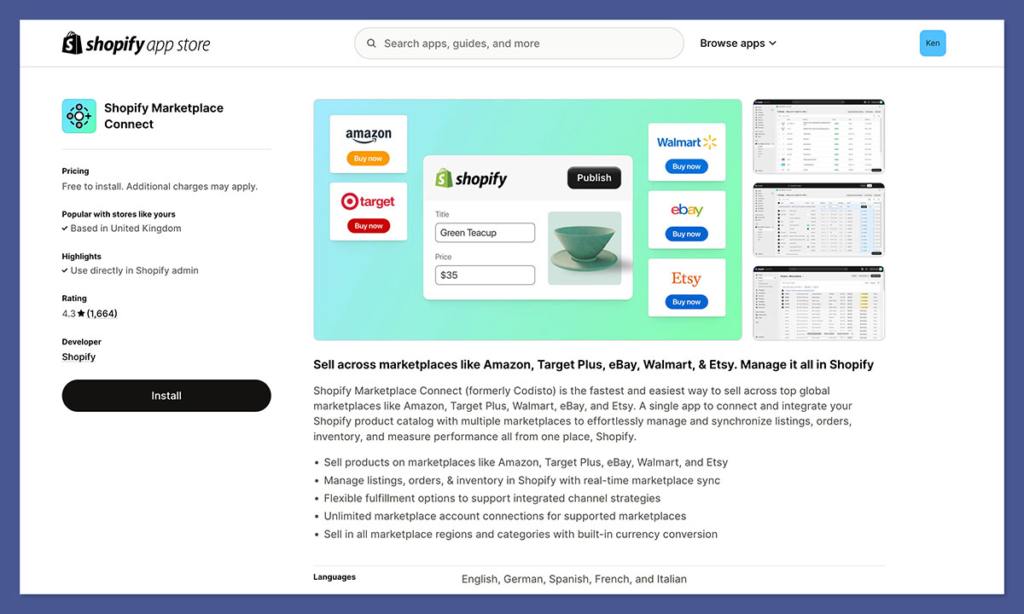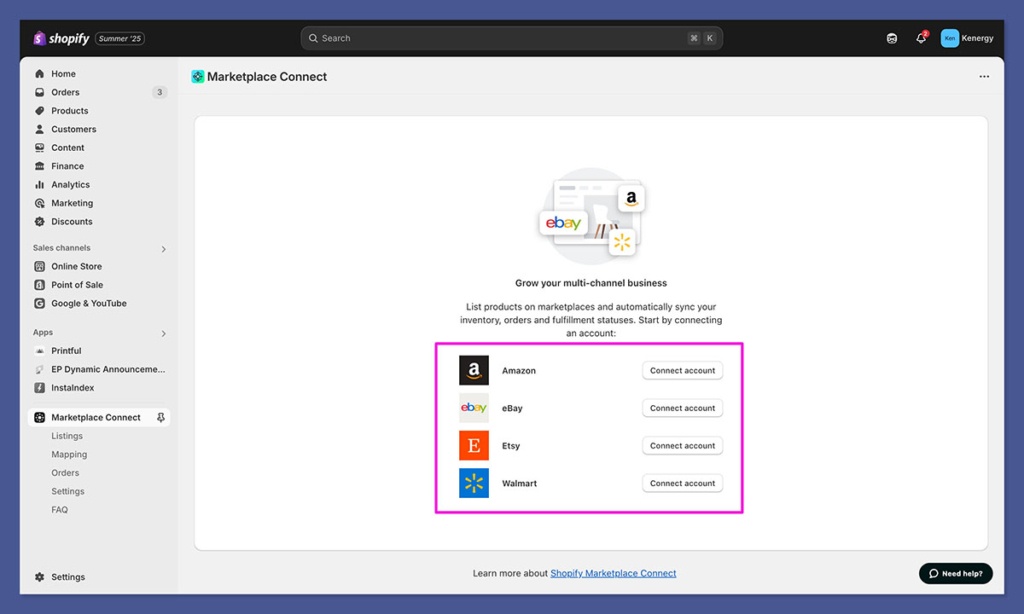
I’ve been working in the Shopify ecosystem for over a decade.
Built two successful public apps, helped scale multi-store setups, dealt with more plugin nightmares than I’d care to admit.
When Shopify absorbed Codisto and rebranded it as Shopify Marketplace Connect, I paid attention.
I’ve used this app across different merchant setups — single-brand stores, large catalog sellers, hybrid Amazon/Etsy shops.
Today I’m going to give you my straight-up review of Marketplace Connect: how it works, when it shines, when it absolutely doesn’t, and how to get the most out of it if you decide to use it.
What Is Shopify Marketplace Connect?
Shopify Marketplace Connect is a native Shopify app that lets you connect your product catalog and orders to major marketplaces — including Amazon, eBay, Walmart, and Etsy — directly from within your Shopify admin.

It used to be called Codisto before Shopify bought it. The core functionality stayed the same, but since Shopify integrated it into their stack, there’s been more stability and native-level control.
Here’s what the app handles:
| Feature | Description |
|---|---|
| Product Listing | Push products from Shopify to marketplaces |
| Inventory Sync | Real-time updates between channels |
| Price Control | Adjust prices per channel |
| Order Sync | Pull orders from marketplaces into Shopify |
| Bulk Edits | Manage large catalogs efficiently |
| Marketplace Rules | Auto-detects and aligns with channel requirements |
For merchants juggling more than one channel, it’s a game-changer.
But it’s not magic. Like every tool, there’s a right time to use it — and a wrong time.
Who Is This App Actually For?

In my experience, Marketplace Connect works best for:
- Shopify brands already selling on Amazon, eBay, or Etsy
- Stores with 50+ SKUs, ideally with some traction
- Merchants looking to centralize fulfilment workflows inside Shopify
- Teams that understand each marketplace’s listing rules
Where it doesn’t make sense:
- Early-stage merchants who haven’t validated products yet
- Dropshippers with hundreds of constantly changing SKUs
- Anyone who expects it to “just work” out of the box without config
You still need to understand how Amazon listings work, or Etsy tags, or eBay categories. This app makes the syncing part easier, but it won’t teach you channel strategy.
Setup: What It’s Like Getting Started
Installing Marketplace Connect is easy. But setup isn’t plug-and-play.
After install, here’s what usually happens:
- You authenticate your accounts — Amazon, Etsy, eBay, Walmart (optional)
- You map products — you can list them manually or in bulk
- You sync pricing rules — choose fixed, percentage, or channel-specific pricing
- You define shipping & tax logic per channel
- You configure inventory syncing rules
This is where most people mess up: they skip mapping properly.

You’ve got to make sure your product titles, SKUs, and descriptions match marketplace requirements. Amazon, in particular, can be brutal if you don’t meet listing standards.
If you’re already selling on Amazon and try to connect existing listings, use SKU matching carefully. Otherwise, you’ll end up creating duplicates or overwriting data unintentionally.
Pros: What Marketplace Connect Does Well
I’ll start with the good — and there’s plenty of it.
1. True Native Integration
Since Shopify owns the app now, it behaves more like a core feature. That means:
- Seamless updates from Shopify’s backend
- No weird plugin conflicts
- More responsive support
That alone makes it a better long-term option than tools like CedCommerce or Sellbrite, in my opinion.
2. Centralized Order Fulfilment
You no longer need to jump between platforms. Orders from Amazon, Etsy, or eBay land inside your Shopify dashboard. You fulfill them like any other order.
Saves time, reduces human error, and helps your team stay in one platform.
3. Inventory Syncing That Works
Inventory updates in real time. This is huge. You won’t accidentally oversell on Amazon because you made a sale on Shopify.
In the past, clients had to wait hours for syncs to happen. Now, updates are instant.
4. Bulk Listing Tools
You can push dozens or hundreds of products live with bulk tools — apply templates, categories, tags, and even set up marketplace-specific overrides without doing it one by one.
This is a lifesaver if you’ve got more than 100 SKUs.
Cons: Where Marketplace Connect Falls Short
This app isn’t perfect. There are a few consistent pain points I’ve seen across installs.
1. The Interface Is Confusing
Even after 10+ years on the platform, I still find the UI frustrating. It’s not always clear what happens when you sync a product — especially when trying to update existing marketplace listings.
There’s a learning curve. Expect to spend 1–2 days getting used to it.
2. Limited Template Customisation
Compared to something like Amazon’s native listing tools or Sellbrite’s rule-based mapping, Marketplace Connect gives you less control over advanced fields.
If you want deep category refinements or conditional logic, it’s not there yet.
3. Pricing Plans Add Up
You get 50 marketplace orders/month for free. After that, the paid plans start around $34/month and scale up based on order volume.
For low-volume sellers, this feels fair. For high-volume, it can get expensive — especially when you’re also paying Shopify Plus or other SaaS tools.
4. Limited Automation
There are no conditional rules based on tags, product types, or metafields yet. You can’t do something like: “Only list products tagged ‘Amazon’ if they’re in stock and priced over $20.”
That’s a big limitation for teams used to advanced logic.
Real Examples: What It Looks Like in Practice
Let me share a few quick examples from projects I’ve worked on.
Case 1: 6-Figure Amazon Brand Using Shopify as HQ
One of our clients sells auto accessories. They used to run Amazon + eBay + Etsy via different tools, but data was all over the place.
After we set up Marketplace Connect:
- Orders from all channels came into Shopify
- Inventory synced from their warehouse app (via Shopify)
- Their VA team managed listings directly from Shopify
Result: fewer stockouts, faster support, smoother operations. They now do 70% of total volume through Amazon, but Shopify is their nerve center.
Case 2: Fashion Brand Scaling to eBay
Another client with 200+ SKUs in women’s clothing wanted to test eBay.
We used Marketplace Connect to:
- Push 40 bestsellers to eBay
- Sync pricing slightly higher (5% markup via pricing rules)
- Auto-pull orders into Shopify for their 3PL
They saw a 12% lift in total orders over 90 days without needing new staff.
Pro Tips from Experience
Here’s what I’ve learned setting this app up across multiple stores:
- Set up test listings before bulk-publishing. Avoid damaging your Amazon account.
- Use SKU-based linking for existing listings — don’t rely on title matching.
- Segment your catalog by tags or collections and only sync what’s relevant.
- Keep marketplace requirements in mind — especially image sizes, variation formatting, and category restrictions.
- Use Shopify Flow or tags to manage what gets synced.
You’ll avoid 90% of problems just by doing those five things.
Should You Use Marketplace Connect?
Here’s the bottom line:
If you’re selling on multiple marketplaces and want to centralize your operations inside Shopify, this is your best option — especially now that it’s owned by Shopify and deeply integrated.
But don’t expect it to be hands-off.
You’ll still need someone on your team who understands the marketplaces you’re selling on. You’ll still need to clean up data and optimize listings. This app helps you execute, but it doesn’t replace strategy.
Alternatives You Might Consider
Let’s compare a few other popular tools, just to give context:
| App | Pros | Cons |
|---|---|---|
| CedCommerce | Supports niche marketplaces | UI is worse, support slower |
| Sellbrite | Advanced automation, rule logic | More expensive, separate login |
| ChannelAdvisor | Enterprise-grade features | Very expensive, steep learning |
| LitCommerce | Simple UI, good Etsy support | Lacks deep Shopify integration |
If you’re a Shopify-first brand, Shopify Marketplace Connect wins on simplicity and native support. For power sellers with complex catalogs or advanced pricing rules, Sellbrite or ChannelAdvisor might be better.
Final Thoughts
As someone who’s built Shopify apps and worked with multi-channel merchants for years, I think Shopify Marketplace Connect is one of the most useful native apps Shopify has rolled out in a long time.
It’s not flashy, but it solves real pain:
- You save hours on listings
- You avoid overselling
- You stop wasting time jumping between dashboards
If you’re already managing multiple channels or planning to expand beyond Shopify, I’d recommend giving it a shot — but take your time to set it up properly.
There’s a steep learning curve at first, but once it’s dialled in, it works.






